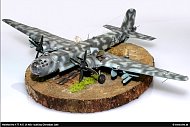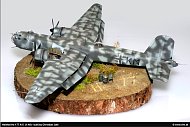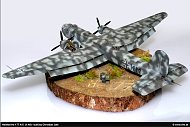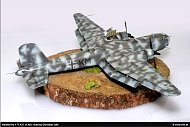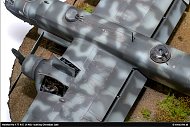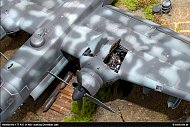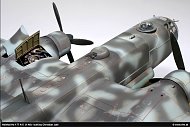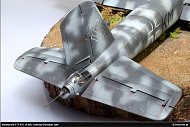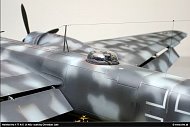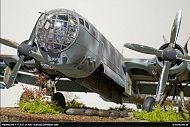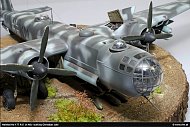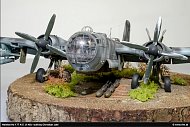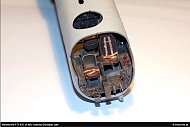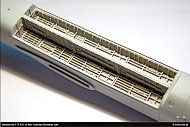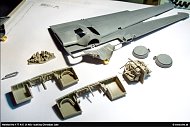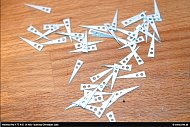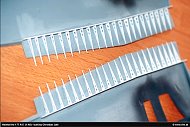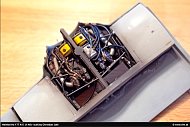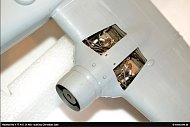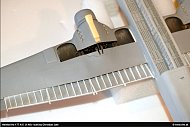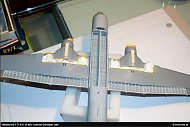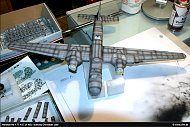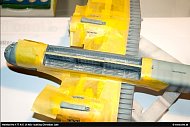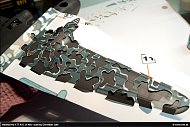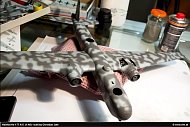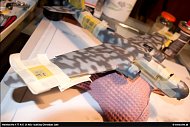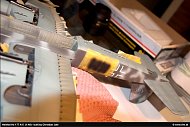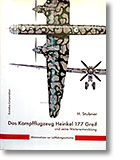 |
 |
 |
 |
 |
 |
 |
 |
|
Heinkel He 177 A-5 |
built by Christian Jakl (1/48) |
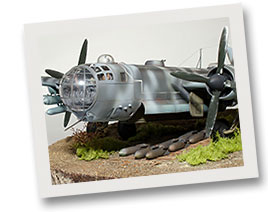 The Heinkel 177 “Greif” was a heavy bomber with four engines and this makes it the only purpose designed strategic bomber of the German Lufwaffe. The engine arrangement was unusual in that the engines were coupled together (DB 606- 610) driving one propeller. The reason for this unusual arrangement was less drag as well as dive-bombing capability. Major problems were soon evident. The first proto-type flew in 1939 and was powered by two 2700 hp DB 606 engines (two DB 601 engines coupled together). This engine arrangement led to overheating and two crashes. Similar occurrences in later proto-types led to the designation of “burning coffin” or “ Reich’s torch” Despite the unreliable power train and other problems the work on the He 177 A-0 and A-1 series continued. Possible changes to the power arrangement which would have made the aircraft safer were ignored. There was a total of 1140 He-177 of all variants built. The problem with the coupled engines was never really solved. Only in August 1943 was the aircraft declared fit for frontline service. Only a third of all aircraft built ever saw service, trained crews and fuel were also lacking. The missions of I. KG 50 to Stalingrad during January 1943 to help supply the 6th Army caused the loss of 5 aircraft. Starting in November 1943, KG 40 flew on naval operations from Bordeaux-Merignac. During “Operation Steinbock” in January 1944, KG 100 flew bombing missions over England. The last operations were flown by KG 1 against Russian armor concentrations during “Operation Bagration” in July 1944 on the Eastern front. Remarkable were the possible armaments options for the He-177: 3x7.92mm-MG 81, 3x13mm MG 131, 2x20mm-MG 151/20. The bomb- bay could carry: 48xSC-50 bombs, 12x –SC-250 bombs, 6x-SC-500 bombs, or 4x SC-1400 bombs or a total of 7300 kg of bombs. External load: 2x LMA-III sea mines, 2 x LT 50 Torpedoes, 3x Henschel HS 293a or 3x Fritz X remote controlled smart bombs. During 1944 a conventional 4 engine configuration was suggested and a few were built but never went to series production. |
For a long time this “High Tech” kit gathered dust on my shelf. I really didn’t dare touch this He 177 A-5 kit. I had bought extra market such as wheel wells, bomb bay and detailed engines from CMK before. With MPM kids you can count on thick plastic and rough small parts. There is no other kit in 1/48 scale. The “High- Tech” version has resin parts for the cockpit as well as masks for the canopy. There are some problems with the masks since they tend to curl up in some of the curved parts. The kit construction went fairly quickly despite early reservations. The thickness of the kit part presented problems only when they had to be sanded after market parts had to be added and the surface had to be pierced and the thickness had to be adjusted. The resin parts in the cockpit are extremely fine and this is important since the cockpit allows a clear vision of the interior. The anti-glare curtains were fashioned from Kleenex drenched in white glue and then fastened with Tamiya yellow tape. I added a few wires behind the instrument panels and the cockpit was finished. The fit of the cockpit into the fuselage was perfect. Large aircraft with large surfaces just look a bit plump. The He 177 was after all the only aircraft that had a bomb bay similar to Allied aircraft. The special engine installations also have to be taken into considerations. Both are available from CMK and are easily installed. The bomb bay (CMK 4175) consists of two resin parts, two inner walls and twelve opening flaps. After a little adjustment it slips easily into the proper space. The landing gear wells (CMK 4176) and the double engines (CMK 4174) installations are child’s play. The engines have to have fuel lines and other various details painted and installed. The barrels for the MG 17, MG 131and the MG 151/20 were substituted with Aber turned brass barrels. Elevator and rudders are contained in the kit and are movable. Strangely the landing flaps have to be carefully scratch built. In the 1/72 kit they are offered but not in the 1/48 kit. The flaps could not only be operated in the normal way but could be completely extended (for dive bombing capability). I reproduced these with Evergreen plastic sheet measuring and cutting ad nauseum. It was difficult but worth it in the end. Yes, the painting of this aircraft is elaborate. There are plenty of variants on the Internet but I decided to do one suggested by MPM. The “cat spot” camouflage of 4./KG100 (used during “Operation Steinbock”) consisted of RLM 65 (under surfaces) RLM 74 and 76 (upper surfaces). If I had done the camouflage by hand I would have flipped out. I simply scanned the pattern and printed it on heavy paper stock. Then I cut the pattern out with a sharp knife. I rolled some small pieces of Tamiya yellow tape to lift the paper 2mm from the surface in order to avoid a sharp contrast when spray painting . Any errors were then corrected by hand. The large markings such as Balkenkreuze and numbers were cut from stencils and then sprayed. Tips for that can be found on this website under “Themes”. I did want a display stand for this model and settled on a flat cut piece of tree trunk. With a little sand, wood, stones and other materials I created a little scene and added 500Kg bombs from CMK (4243). A few barrels and a board with the designation A4 was added for a little interest. Special thanks to Gerald Kohler (manager of Planlicht) for providing the wooden base. Planlicht provides a good source for lighting for modelers who have to replicate daylight conditions in dark work areas. It is work a look at www.planlicht.com |
|
|||||||||||||||||||||
|
|||||||||||||||||||||||||||||||||||||||||||
|
|
||||||||
| This page: GALLERY: Heinkel He 177 A-5 (1/48), built by Christian Jakl was last modified on: Feb 25, 2015 The URL of the page is: http://www.rlm.at/cont/gal44_e.htm Translation into English by Werner Stocker (Ft. Myers, FL USA). © Copyright www.rlm.at and the contributing author(s). All Rights Reserved. Used with permission. Terms of use: All material within this site is protected under copyright and may only be reproduced for personal use. You must contact the Author(s) and/or Editor for permission to use any material on this site for any purpose other than private use! |
